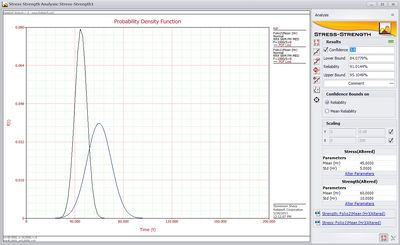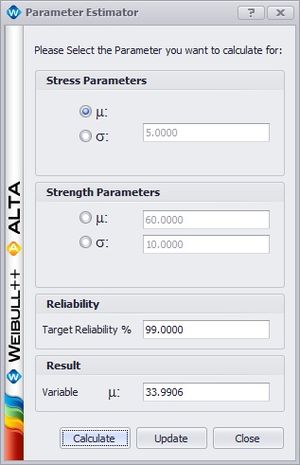Template:Stress-strength analysis: Difference between revisions
No edit summary |
|||
| Line 3: | Line 3: | ||
Stress-Strength analysis has been used in mechanical component design. The probability of failure is based on the probability of stress exceeding strength. The following equationi usually is used to calculate the probability of failure: | Stress-Strength analysis has been used in mechanical component design. The probability of failure is based on the probability of stress exceeding strength. The following equationi usually is used to calculate the probability of failure: | ||
<math>P[Stress\ge Strength]=\int_{0}^{\infty }{{{f}_{Strength}}(x)\cdot {{R}_{Stress}}(x)}dx</math> | <center><math>P[Stress\ge Strength]=\int_{0}^{\infty }{{{f}_{Strength}}(x)\cdot {{R}_{Stress}}(x)}dx</math></center> | ||
In this case, the data for the strength set would be actual data that is indicative of the strength of the material (i.e. maximum applied stress to cause failure), and the stress data would be actual stress data of the material under use conditions. Weibull++'s Stress-Strength Wizard allows you to perform such calculations. | |||
The Stress-Strength Calculator is accessible from the Tools folder of the Project Explorer. The tool first asks for the locations of the stress and strength data from among the folios available, as shown below. | The Stress-Strength Calculator is accessible from the Tools folder of the Project Explorer. The tool first asks for the locations of the stress and strength data from among the folios available, as shown below. | ||
Revision as of 17:26, 27 February 2012
Stress-Strength Analysis
Stress-Strength analysis has been used in mechanical component design. The probability of failure is based on the probability of stress exceeding strength. The following equationi usually is used to calculate the probability of failure:
In this case, the data for the strength set would be actual data that is indicative of the strength of the material (i.e. maximum applied stress to cause failure), and the stress data would be actual stress data of the material under use conditions. Weibull++'s Stress-Strength Wizard allows you to perform such calculations.
The Stress-Strength Calculator is accessible from the Tools folder of the Project Explorer. The tool first asks for the locations of the stress and strength data from among the folios available, as shown below.
Once the tool knows where to find data for stress and strength, it automatically calculates the reliability and graphs the distributions of the stress and strength data, as shown below.
Once the reliability has been calculated, the user has two different options for performing sensitivity analysis (seeing how the system performance changes with changes in parameter values). The user can manually alter the distribution parameters used to calculate the reliability by clicking the “Alter Parameters” link for the appropriate distribution, or the user can use the Parameter Estimator to find what parameters result in a specified target reliability. The “Alter Parameters” link allows the user to manually set what she would like the distribution parameter(s) to be. Alternatively, the Parameter Estimator utility allows the user to select a target reliability to reach and a distribution parameter to adjust. The utility then adjusts the parameter value until the specified target is reached and outputs the parameter value that does so, as shown below.

